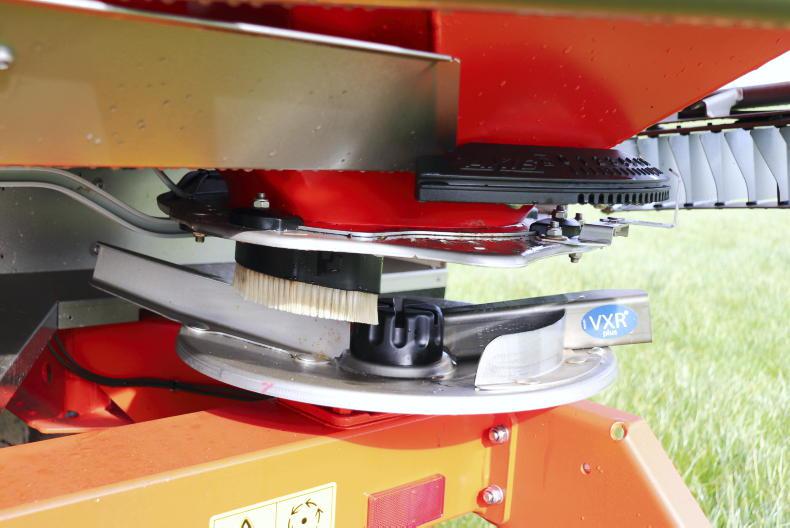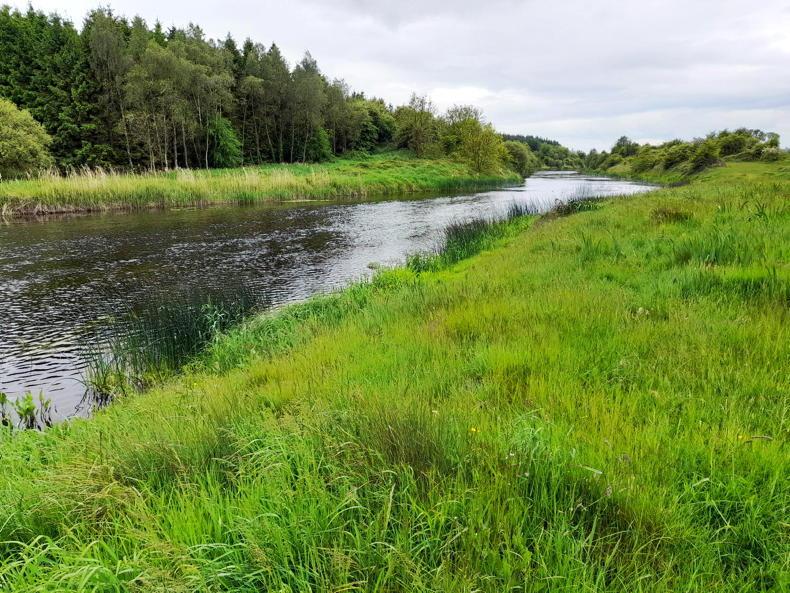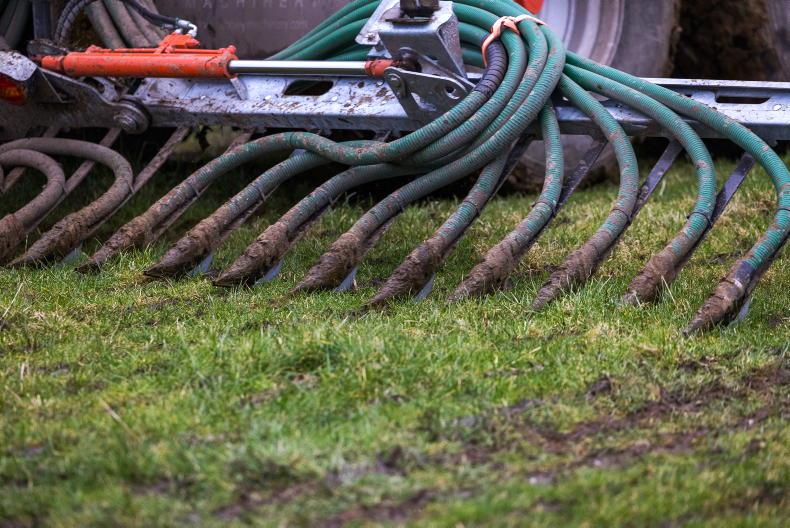Over the next few weeks, plenty of farmers will set out to spread fertiliser for the first time this year and will scratch their heads trying to think of the correct settings. It is even more complicated trying to set up new fertiliser spreaders. Not knowing if you’re applying fertiliser at the correct rate is a very uncomfortable position to be in. Some farmers have to wait until the bag runs out and then assess the area spread.
If the fertiliser spreader is set up correctly, this uncertainty can be avoided. Modern fertiliser spreaders are sophisticated machines and with the cost of fertiliser now, they should be used correctly to ensure fertiliser is not being wasted.
Higher end manufacturers of fertiliser spreaders will test a whole range of commonly used fertilisers and then suggest the correct setting for each type at different rates and spreading widths.
Interpreting their recommendations for setting up the spreader can take a bit of getting used to. There are typically five areas of the machine to adjust before one goes spreading. These are; the height of the spreader off the ground, the rate setting, the vane setting and the forward and PTO speed.
Depending on the crop and the spreading width, the front part of the spreader may be at a different height to the back of the spreader. This can be set by adjusting the top-link, but they are usually level for spreading on grassland.

Adjust spreading vanes in line with the spreader settings for that fertiliser type.
Most high-end manufacturers now use smartphone apps to help operators determine the correct setting, replacing the need to go searching through calibration chart books that come with the spreader. Most of the commonly used Irish fertiliser brands will have been tested by the manufacturers and will be on the app or in the chart book.
Rates
Most Irish farmers think of fertiliser in terms of units/acre, bags/acre or kg N/ha. However, when looking at the fertiliser spreader charts – whether on an app or in the chart book – fertiliser spreading rates will be given in terms of kg/ha.
This refers to the kilos of actual fertiliser product being applied per hectare and is very different from kg N/ha, which is the kilos of actual nitrogen in the pure nutrient form being applied per hectare.
Therefore, to work out how much kg/ha you want to apply, divide the kg N/ha figure by the percentage of nitrogen in the fertiliser. For example, if you want to spread urea (46% nitrogen) at a rate of 30kgN/ha, you divide 30 by 0.46, which is 65kg/ha. When setting up the fertiliser spreader, check the correct settings for a 65kg/ha application rate.
To convert units/acre to kg N/ha, multiply by 1.25. If you want to convert bags/acre to units/acre, multiply by the percentage of nitrogen in the fertiliser. For example, 1.5 bags/acre of 18:6:12 is 27 units/acre (18 x 1.5).
Fertiliser advice
The Teagasc fertiliser advice for those looking for high pasture yields per hectare is outlined in Table 1. The chart shows the total amount of chemical nitrogen to be applied per month. In most cases, this will be split between various applications.
In February, it is presumed that 70% of the farm will get slurry at some stage, either before or after grazing, which means only 14kg N/ha of chemical fertiliser is spread at that stage.
Advice is tailored depending on clover content, and fields with high clover content greater than 25% clover on average, getting a maximum of 150kg N/ha, while all other fields get 225kg N/ha, which is the new maximum under the new nitrates rules. Of course, farmers should be judging for themselves how much chemical nitrogen to apply depending on grass growth, weather, clover content and the demand for grass.
As can be seen in the table, Teagasc advice is similar for grass and grass plus clover swards up to May, at which point the rate of nitrogen on clover swards is halved for most of the summer. This is because clover should be contributing the most biological nitrogen in that period.
Ensure that fertiliser spreader settings are as per manufacturers’ recommendations for the type and rate of fertiliser being spread. Height off the ground, flow rate setting, forward speed, PTO speed and vanes all need to be adjusted depending on the rate and type of fertiliser being spread.
Fertiliser spreader spreading rate charts are in terms og kilos of product per hectare, while farmers usually refer to fertiliser in units/ac or kg N/ha.
These rates need to be converted to kg/ha when deciding on what setting to use for the fertiliser spreader.
Teagasc advice for farms requiring high grass yield is to apply 225kg N/ha per year and 150kg N/ha on fields with a high clover content, greater than 25% clover on average.
Over the next few weeks, plenty of farmers will set out to spread fertiliser for the first time this year and will scratch their heads trying to think of the correct settings. It is even more complicated trying to set up new fertiliser spreaders. Not knowing if you’re applying fertiliser at the correct rate is a very uncomfortable position to be in. Some farmers have to wait until the bag runs out and then assess the area spread.
If the fertiliser spreader is set up correctly, this uncertainty can be avoided. Modern fertiliser spreaders are sophisticated machines and with the cost of fertiliser now, they should be used correctly to ensure fertiliser is not being wasted.
Higher end manufacturers of fertiliser spreaders will test a whole range of commonly used fertilisers and then suggest the correct setting for each type at different rates and spreading widths.
Interpreting their recommendations for setting up the spreader can take a bit of getting used to. There are typically five areas of the machine to adjust before one goes spreading. These are; the height of the spreader off the ground, the rate setting, the vane setting and the forward and PTO speed.
Depending on the crop and the spreading width, the front part of the spreader may be at a different height to the back of the spreader. This can be set by adjusting the top-link, but they are usually level for spreading on grassland.

Adjust spreading vanes in line with the spreader settings for that fertiliser type.
Most high-end manufacturers now use smartphone apps to help operators determine the correct setting, replacing the need to go searching through calibration chart books that come with the spreader. Most of the commonly used Irish fertiliser brands will have been tested by the manufacturers and will be on the app or in the chart book.
Rates
Most Irish farmers think of fertiliser in terms of units/acre, bags/acre or kg N/ha. However, when looking at the fertiliser spreader charts – whether on an app or in the chart book – fertiliser spreading rates will be given in terms of kg/ha.
This refers to the kilos of actual fertiliser product being applied per hectare and is very different from kg N/ha, which is the kilos of actual nitrogen in the pure nutrient form being applied per hectare.
Therefore, to work out how much kg/ha you want to apply, divide the kg N/ha figure by the percentage of nitrogen in the fertiliser. For example, if you want to spread urea (46% nitrogen) at a rate of 30kgN/ha, you divide 30 by 0.46, which is 65kg/ha. When setting up the fertiliser spreader, check the correct settings for a 65kg/ha application rate.
To convert units/acre to kg N/ha, multiply by 1.25. If you want to convert bags/acre to units/acre, multiply by the percentage of nitrogen in the fertiliser. For example, 1.5 bags/acre of 18:6:12 is 27 units/acre (18 x 1.5).
Fertiliser advice
The Teagasc fertiliser advice for those looking for high pasture yields per hectare is outlined in Table 1. The chart shows the total amount of chemical nitrogen to be applied per month. In most cases, this will be split between various applications.
In February, it is presumed that 70% of the farm will get slurry at some stage, either before or after grazing, which means only 14kg N/ha of chemical fertiliser is spread at that stage.
Advice is tailored depending on clover content, and fields with high clover content greater than 25% clover on average, getting a maximum of 150kg N/ha, while all other fields get 225kg N/ha, which is the new maximum under the new nitrates rules. Of course, farmers should be judging for themselves how much chemical nitrogen to apply depending on grass growth, weather, clover content and the demand for grass.
As can be seen in the table, Teagasc advice is similar for grass and grass plus clover swards up to May, at which point the rate of nitrogen on clover swards is halved for most of the summer. This is because clover should be contributing the most biological nitrogen in that period.
Ensure that fertiliser spreader settings are as per manufacturers’ recommendations for the type and rate of fertiliser being spread. Height off the ground, flow rate setting, forward speed, PTO speed and vanes all need to be adjusted depending on the rate and type of fertiliser being spread.
Fertiliser spreader spreading rate charts are in terms og kilos of product per hectare, while farmers usually refer to fertiliser in units/ac or kg N/ha.
These rates need to be converted to kg/ha when deciding on what setting to use for the fertiliser spreader.
Teagasc advice for farms requiring high grass yield is to apply 225kg N/ha per year and 150kg N/ha on fields with a high clover content, greater than 25% clover on average.











SHARING OPTIONS